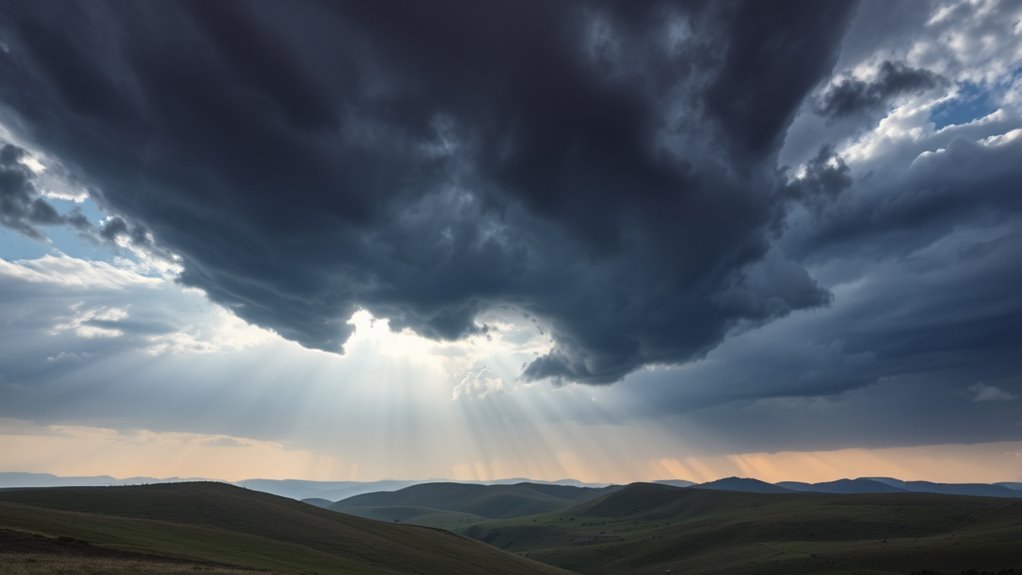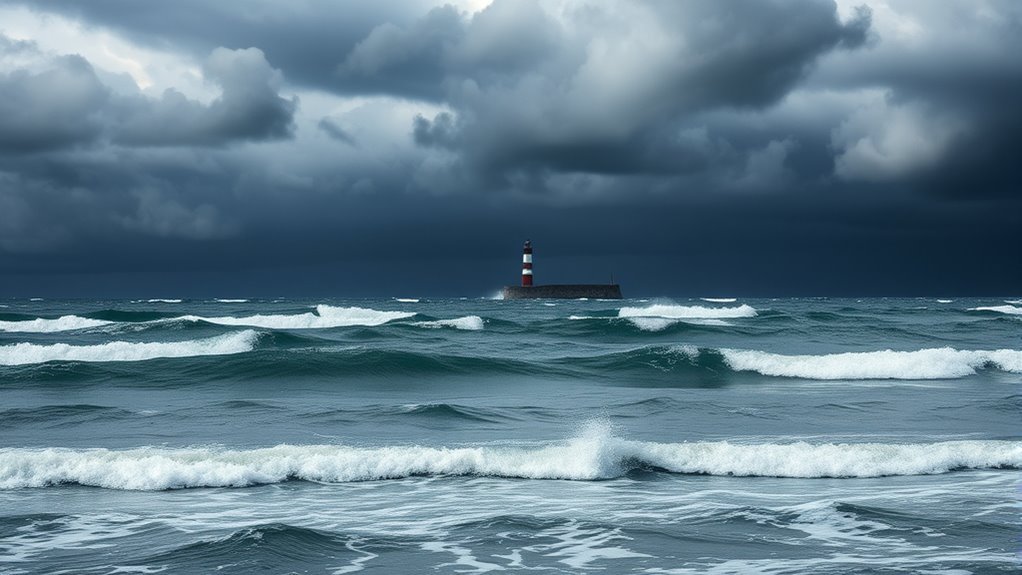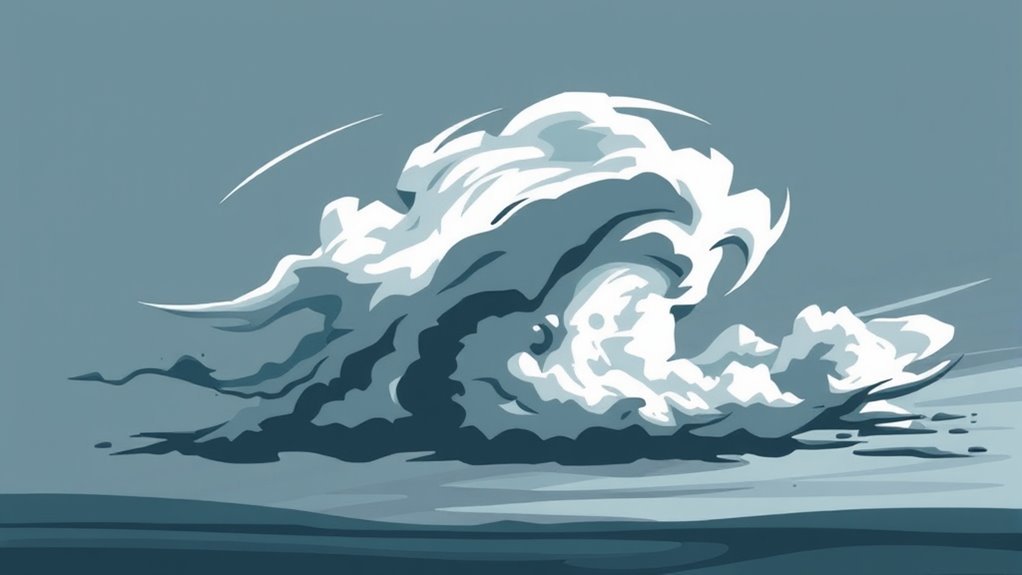Squalls are often misunderstood intense weather events that typically involve sudden, brief bursts of wind and precipitation. Many believe squalls only occur during thunderstorms or last for extended periods, but they are usually short-lived and can arise unexpectedly, particularly with cold front passages. These misconceptions can lead to underestimating the risks squalls pose, which can include reduced visibility and potential flooding. Understanding these facts is essential, and further details reveal how to prepare effectively for such weather phenomena.
Main Points
- Many believe squalls only occur during thunderstorms, but they can also develop with cold fronts without thunderstorms present.
- Squalls are often misunderstood as lasting for extended periods, when they typically last only a few minutes to half an hour.
- Some underestimate squalls as harmless, but they can produce intense winds and heavy precipitation, leading to dangerous conditions.
- Squalls are frequently confused with tornadoes or hurricanes, despite being brief and distinct weather phenomena with different formation mechanisms.
- Awareness and education about squalls are crucial for safety, enabling communities to prepare effectively for sudden weather changes.
What Exactly Is a Squall?
A squall is a sudden, brief, and intense burst of wind, often accompanied by precipitation. These meteorological phenomena can occur in various environments, from coastal regions to inland areas.
Squalls typically develop when a cold front moves through an area, causing a rapid change in atmospheric conditions. The wind speeds during a squall can reach up to 50 knots or more, creating hazardous conditions for marine and aviation activities.
The precipitation associated with squalls can vary from light rain to heavy downpours, and occasionally hail. Squalls are generally short-lived, lasting only a few minutes to half an hour, but their impact can be considerable.
Understanding the nature of squalls is essential for safety and preparedness, especially for those in affected regions. Meteorologists utilize advanced radar technology to monitor these events, providing timely warnings to help mitigate potential risks associated with sudden wind shifts and heavy rainfall.
Common Myths About Squalls

What misconceptions surround squalls that might lead to dangerous situations? Many individuals believe that squalls only occur during thunderstorms, neglecting their potential to develop in clear skies. This misunderstanding can result in unpreparedness, as squalls often strike suddenly and violently.
Another prevalent myth is that squalls last for extended periods; nevertheless, they are typically short-lived, often lasting only minutes. This brevity can mislead people into underestimating their severity.
Some also assume that squalls are harmless, overlooking the fact that they can produce strong winds and heavy precipitation, posing considerable risks to both outdoor activities and transportation.
Additionally, many erroneously think that squalls are the same as tornadoes or hurricanes. Such misconceptions can lead to confusion and inadequate responses when faced with actual squall conditions.
In the end, awareness and education about these myths are essential for ensuring safety during unexpected weather changes.
The Difference Between Squalls and Regular Storms
Understanding the difference between squalls and regular storms is essential for accurate weather forecasting.
Squalls are defined by short bursts of intense weather, while regular storms can last longer and vary in intensity.
Additionally, the formation mechanisms of squalls differ considerably from those of typical storm systems.
Definition of Squalls
Squalls are sudden, intense bursts of wind and rain that can occur with little warning, distinguishing them from regular storms, which typically develop over a longer period.
Squalls can manifest rapidly, often associated with a cold front or shifting weather patterns. Unlike traditional storms, which generally lead to a gradual buildup of atmospheric conditions, squalls present an abrupt change, catching many off guard.
These phenomena can vary in scale, from localized gusts affecting small areas to broader impacts felt over larger regions. The duration of squalls is typically brief, and they may not warrant the same level of alertness or preparation as more prolonged storm systems.
Understanding this distinction is essential for effective weather preparedness and response strategies.
Duration and Intensity
The duration and intensity of squalls set them apart from regular storms, which often unfold over extended periods and build gradually.
Squalls are defined by their brief but intense bursts of wind and precipitation, typically lasting minutes to a few hours. This sudden onset can lead to dramatic changes in weather conditions, catching individuals unprepared.
In contrast, regular storms may develop slowly, allowing for increased awareness and preparation. The intensity of squalls can be deceptive; while they may not last long, the severe wind gusts and heavy rainfall can cause considerable damage.
Understanding these differences is essential for accurate weather assessments and timely responses, as squalls can produce hazardous conditions that rival those of more prolonged storm systems.
Formation Mechanisms Explained
While many weather phenomena can be categorized as storms, the formation mechanisms behind squalls differ considerably from those of more prolonged systems.
Squalls typically form when a cold front moves rapidly through a warm, moist air mass, creating a sharp temperature contrast. This interaction leads to sudden upward air movement, resulting in intense but short-lived precipitation and gusty winds.
In contrast, regular storms, such as cyclones, develop over extended periods, allowing for more gradual energy accumulation and expansive cloud formation. Additionally, squalls often exhibit a rapid onset and dissipation, while traditional storms can last hours or days.
Understanding these fundamental differences helps clarify why squalls can produce sudden, severe weather despite their brief duration.
Seasonal Patterns and Squalls

Seasonal patterns considerably influence the occurrence and intensity of squalls in various regions.
These atmospheric disturbances often correlate with specific times of the year, shaping local weather conditions and impacting communities. Understanding these patterns is vital for anticipating squall events and preparing for their consequences.
- Winter Months: Squalls are more prevalent during winter due to colder air masses colliding with warmer fronts.
- Stormy Summers: Summer can also see squalls, particularly in tropical regions, where heat and humidity create unstable air.
- Transition Seasons: Spring and fall may produce squalls as temperatures fluctuate, leading to rapid weather changes.
- Geographic Influence: Coastal areas often experience squalls differently than inland regions, influenced by oceanic conditions and land formations.
Recognizing these seasonal trends helps improve forecasting and mitigates the potential dangers associated with these sudden weather events.
Regional Variations in Squall Occurrence

How do regional characteristics shape squall occurrences? Variations in geography, climate, and local weather patterns greatly influence the frequency and intensity of squalls.
Coastal regions, for instance, often experience more squalls due to the clash of warm, moist air from the ocean with cooler air over land. This interaction can lead to sudden, intense storms. In contrast, arid regions may see fewer squalls, primarily due to the lack of moisture necessary for their formation.
Mountainous areas also play a vital role in squall development. The orographic lifting of air can improve instability, resulting in more frequent and severe squalls.
Additionally, urban heat islands may amplify local weather conditions, contributing to squall formation in metropolitan areas. Understanding these regional variations is essential for predicting squall behavior and mitigating potential impacts on communities.
Each region's unique characteristics fundamentally dictate how often squalls manifest and their overall intensity.
The Impact of Squalls on Local Weather
Squalls can particularly alter local weather conditions, often leading to abrupt changes in temperature, wind speed, and precipitation. These sudden shifts can have considerable effects on both the environment and daily life. Meteorologists observe that squalls can occur with little warning, catching individuals unprepared.
The impact of squalls includes:
- Rapid temperature drops, making conditions feel much colder.
- Increased wind speeds, which can create hazardous situations, especially for outdoor activities.
- Intense, short-lived rainfall or snowfall, leading to reduced visibility and potential flooding.
- Dramatic shifts in atmospheric pressure, influencing local weather patterns for hours or even days.
Understanding the consequences of squalls is vital for communities, as these phenomena can disrupt normal routines and pose risks to safety.
Acknowledging their potential impact can encourage greater awareness and preparedness among residents.
Preparing for Squalls: Tips and Strategies
Preparing for squalls requires careful attention to essential safety gear and the importance of monitoring weather updates.
Individuals should guarantee they have appropriate equipment ready and stay informed about changing conditions.
Essential Safety Gear
Essential safety gear is essential for anyone venturing into areas prone to squalls.
Being adequately prepared can greatly improve safety and reduce the risks associated with sudden weather changes.
Essential items to take into account include:
- Waterproof clothing: Protects against heavy rain and wind.
- Life jacket: Critical for those near water, ensuring buoyancy during sudden conditions.
- Emergency whistle: A reliable tool for signaling distress in adverse weather.
- First aid kit: Essential for treating injuries sustained during unexpected weather events.
Monitoring Weather Updates
While venturing into areas susceptible to sudden weather changes, staying informed about the latest weather updates is essential. Individuals should utilize reliable sources such as weather apps, websites, and local news stations to receive timely alerts about squalls.
Setting up notifications can help guarantee that updates reach them immediately, allowing for quick responses to changing conditions. Additionally, monitoring radar systems and satellite imagery can provide real-time perspectives into approaching weather patterns.
It is also advisable to familiarize oneself with the terminology used in weather forecasts, as this can aid in understanding the severity of potential squalls. By prioritizing weather awareness, individuals can better prepare for unexpected storms and improve their safety during outdoor activities.
Common Questions
Can Squalls Occur in Any Season or Region?
Squalls can indeed occur in any season or region. Their formation is influenced by atmospheric conditions rather than specific seasonal patterns, making them versatile weather phenomena that can surprise observers regardless of location or time of year.
How Long Do Squalls Typically Last?
Squalls typically last anywhere from a few minutes to an hour. Their duration can vary considerably based on atmospheric conditions, but they are generally brief, defined by sudden changes in wind and precipitation intensity.
Are Squalls More Dangerous Than Hurricanes?
Squalls can be dangerous due to their sudden onset and intense conditions, but hurricanes generally pose a greater threat in general, with larger wind fields, prolonged impacts, and potential for extensive damage and flooding in affected areas.
Do Squalls Cause Any Long-Term Weather Changes?
Squalls typically do not cause long-term weather changes. They are short-lived phenomena, defined by sudden, intense wind and precipitation, which generally revert back to prevailing weather patterns shortly after their occurrence, leaving little lasting impact.
Can Technology Predict Squalls Accurately?
Current advancements in meteorological technology improve the accuracy of squall predictions. Utilizing radar, satellite imagery, and advanced algorithms, forecasters can identify potential squall development, although challenges remain due to their sudden and localized nature.

